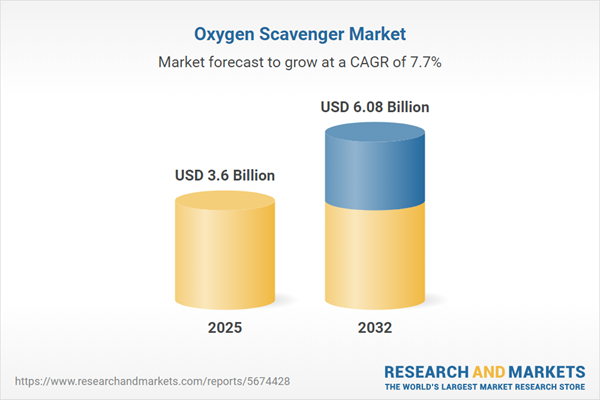Speak directly to the analyst to clarify any post sales queries you may have.
The oxygen scavenger market plays a pivotal role in supporting modern industrial operations, ensuring product shelf life, safety, and system integrity across diverse sectors. As industries demand smarter preservation and compliance solutions, the market is adapting through technology, regulatory alignment, and sustainability initiatives.
Market Snapshot: Oxygen Scavenger Market Overview
The oxygen scavenger market expanded from USD 3.35 billion in 2024 to USD 3.60 billion in 2025 and is projected to grow at a CAGR of 7.71%, reaching USD 6.08 billion by 2032. The consistent market momentum reflects operator focus on protecting packaged foods, pharmaceuticals, pipelines, and water systems from oxidative degradation. The market’s expansion is underpinned by demand for high-efficiency additives, enhanced by innovation in both organic and inorganic chemistry.
Scope & Segmentation: In-Depth Oxygen Scavenger Market Coverage
This report explores comprehensive segmentation across products, applications, packaging, and regional markets. Segmentation depth enables stakeholders to assess opportunities and align offerings precisely.
- Type: Inorganic oxygen scavengers (metallic-based compounds, non-metallic-based compounds), organic oxygen scavengers (ascorbic acid, diethylhydroxylamine, hydrazine).
- Form: Film, liquid, powder.
- Packaging Type: Bottle, canister, carton, pouch, sachet.
- End-User Sectors: Food and beverage, oil and gas, pharmaceutical, power generation, water treatment.
- Sub-Regions: Americas (United States, Canada, Mexico, Brazil, Argentina, Chile, Colombia, Peru); Europe, Middle East & Africa (United Kingdom, Germany, France, Russia, Italy, Spain, Netherlands, Sweden, Poland, Switzerland, United Arab Emirates, Saudi Arabia, Qatar, Turkey, Israel, South Africa, Nigeria, Egypt, Kenya); Asia-Pacific (China, India, Japan, Australia, South Korea, Indonesia, Thailand, Malaysia, Singapore, Taiwan).
- Key Companies: Arkema Group, Avient Corporation, Accepta Ltd, Angus Chemical Company, Baker Hughes Company by GE company, LLC, BASF SE, Chemtex Speciality Limited, Clariant International Ltd, Eastman Chemical Company, Ecolab Inc., Essentra Plc, Evonik Industries AG, Guardian Chemicals Inc., Innospec Inc., Kuraray Co., Ltd., Lubrizol Corporation, Mitsubishi Gas Chemical Company, Multisorb by Filtration Group Corporation, Sealed Air Corporation, Shakti Chemicals, Solenis LLC, Solvay S.A., Tetra Technologies, Inc., Umicore N.V, VEOLIA WATER TECHNOLOGIES and SOLUTIONS.
Key Takeaways: Strategic Insights for Decision-Makers
- Oxygen scavengers are crucial in protecting products from oxidative damage, directly impacting quality assurance, shelf life, and regulatory compliance.
- Technology advances include polymer-embedded and microencapsulated scavenger agents, as well as sensor-enabled real-time monitoring to improve process control.
- Regulations are driving new formulations that meet food-grade, biodegradable, and low-residue standards, while supporting supply chain traceability initiatives.
- Sustainability imperatives are prompting manufacturers to shift toward bio-derived, enzyme-based, or locally sourced scavenger compounds to reduce carbon footprint.
- Strategic partnerships between chemical providers and packaging firms accelerate the integration of scavenger solutions directly into flexible substrates for market differentiation.
- Regional variation in demand reflects local regulatory frameworks, infrastructure investments, and sector priorities—especially in food packaging, energy, and water treatment.
Tariff Impact on the Oxygen Scavenger Market
Recent United States tariffs on select chemical imports have raised input costs and forced many manufacturers to reconsider their supply strategies. Companies are responding by reshoring sourcing, diversifying suppliers, and increasing investment in domestic production capacity for both metallic and non-metallic compounds. Distributors and end-users face pressure to adapt procurement models and evaluate alternative scavenger blends, especially in food packaging and power generation. Exporters and trade partners are seeking free-trade agreements and logistics optimization to reduce tariff exposure and maintain competitive lead times.
Methodology & Data Sources
This report is built on a dual approach of comprehensive secondary research and robust primary data collection. Industry literature, regulatory filings, and company disclosures create a foundation, while interviews and surveys with sector leaders validate real-world usage patterns and procurement drivers. Data is triangulated and enhanced by advanced analysis techniques, ensuring actionable reliability.
Why This Report Matters: Value for Senior Executives
- Enables strategic decisions by mapping technology trends and regulatory developments to future market risks and opportunities.
- Provides a segmented framework to support product, procurement, and territorial growth strategies across the oxygen scavenger value chain.
- Delivers clarity on competitive positioning, innovation trajectories, and sustainable sourcing in a market facing regulatory and supply chain complexity.
Conclusion
Driven by innovation, sustainability goals, and regional dynamics, the oxygen scavenger market continues to evolve. Forward-looking organizations that align R&D, regulatory acuity, and supply chain agility will secure enduring competitive advantage as demands diversify and intensify.
Additional Product Information:
- Purchase of this report includes 1 year online access with quarterly updates.
- This report can be updated on request. Please contact our Customer Experience team using the Ask a Question widget on our website.
Table of Contents
3. Executive Summary
4. Market Overview
7. Cumulative Impact of Artificial Intelligence 2025
List of Figures
Companies Mentioned
The key companies profiled in this Oxygen Scavenger market report include:- Arkema Group
- Avient Corporation
- Accepta Ltd
- Angus Chemical Company
- Baker Hughes Company by GE company, LLC
- BASF SE
- Chemtex Speciality Limited
- Clariant International Ltd
- Eastman Chemical Company
- Ecolab Inc.
- Essentra Plc
- Evonik Industries AG
- Guardian Chemicals Inc.
- Innospec Inc.
- Kuraray Co., Ltd.
- Lubrizol Corporation
- Mitsubishi Gas Chemical Company
- Multisorb by Filtration Group Corporation
- Sealed Air Corporation
- Shakti Chemicals
- Solenis LLC
- Solvay S.A.
- Tetra Technologies, Inc.
- Umicore N.V
- VEOLIA WATER TECHNOLOGIES AND SOLUTIONS
Table Information
| Report Attribute | Details |
|---|---|
| No. of Pages | 184 |
| Published | October 2025 |
| Forecast Period | 2025 - 2032 |
| Estimated Market Value ( USD | $ 3.6 Billion |
| Forecasted Market Value ( USD | $ 6.08 Billion |
| Compound Annual Growth Rate | 7.7% |
| Regions Covered | Global |
| No. of Companies Mentioned | 26 |









